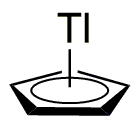Cyclopentadienyl thallium is widely utilized in research focused on:
- Organometallic Chemistry: This compound serves as a precursor for synthesizing various organometallic compounds, which are essential in catalysis and materials science.
- Catalysis: It is used in catalytic processes, particularly in the production of fine chemicals and pharmaceuticals, enhancing reaction efficiency and selectivity.
- Materials Science: Cyclopentadienyl thallium contributes to the development of novel materials, including superconductors and advanced electronic components, due to its unique electronic properties.
- Research in Nanotechnology: The compound is explored for its potential in creating nanoscale materials, which can be applied in electronics and drug delivery systems.
- Analytical Chemistry: It is utilized in the analysis of thallium in various samples, providing a reliable method for environmental monitoring and safety assessments.
General Information
Properties
Safety and Regulations
Applications
Cyclopentadienyl thallium is widely utilized in research focused on:
- Organometallic Chemistry: This compound serves as a precursor for synthesizing various organometallic compounds, which are essential in catalysis and materials science.
- Catalysis: It is used in catalytic processes, particularly in the production of fine chemicals and pharmaceuticals, enhancing reaction efficiency and selectivity.
- Materials Science: Cyclopentadienyl thallium contributes to the development of novel materials, including superconductors and advanced electronic components, due to its unique electronic properties.
- Research in Nanotechnology: The compound is explored for its potential in creating nanoscale materials, which can be applied in electronics and drug delivery systems.
- Analytical Chemistry: It is utilized in the analysis of thallium in various samples, providing a reliable method for environmental monitoring and safety assessments.
Documents
Safety Data Sheets (SDS)
The SDS provides comprehensive safety information on handling, storage, and disposal of the product.
Product Specification (PS)
The PS provides a comprehensive breakdown of the product’s properties, including chemical composition, physical state, purity, and storage requirements. It also details acceptable quality ranges and the product's intended applications.
Certificates of Analysis (COA)
Search for Certificates of Analysis (COA) by entering the products Lot Number. Lot and Batch Numbers can be found on a product’s label following the words ‘Lot’ or ‘Batch’.
*Catalog Number
*Lot Number
Certificates Of Origin (COO)
This COO confirms the country where the product was manufactured, and also details the materials and components used in it and whether it is derived from natural, synthetic, or other specific sources. This certificate may be required for customs, trade, and regulatory compliance.
*Catalog Number
*Lot Number
Safety Data Sheets (SDS)
The SDS provides comprehensive safety information on handling, storage, and disposal of the product.
DownloadProduct Specification (PS)
The PS provides a comprehensive breakdown of the product’s properties, including chemical composition, physical state, purity, and storage requirements. It also details acceptable quality ranges and the product's intended applications.
DownloadCertificates of Analysis (COA)
Search for Certificates of Analysis (COA) by entering the products Lot Number. Lot and Batch Numbers can be found on a product’s label following the words ‘Lot’ or ‘Batch’.
*Catalog Number
*Lot Number
Certificates Of Origin (COO)
This COO confirms the country where the product was manufactured, and also details the materials and components used in it and whether it is derived from natural, synthetic, or other specific sources. This certificate may be required for customs, trade, and regulatory compliance.


